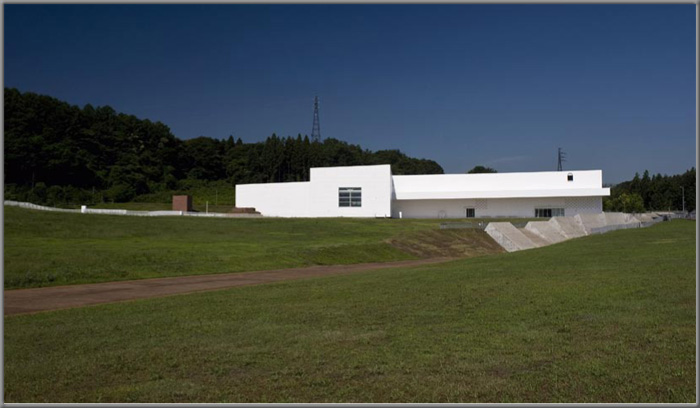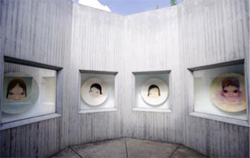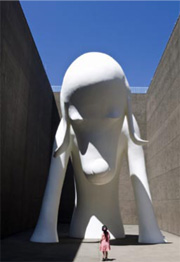Home > Highlighting JAPAN > Highlighting Japan AUGUST 2011 > The Aomori Museum of Art
Highlighting JAPAN
THE NATION’S MUSEUMS

Jun Aoki’s design for the Aomori Museum of Art in Aomori City was inspired by the nearby Sannai Maruyama archeological site.
Credit: ROB GILHOOLY
The Aomori Museum of Art
Opened in 2006, Aomori Museum of Art was built, according to Director Hibari Takayama, "to propagate the culture of the arts of the Northern Tohoku region of Japan." Julian Ryall visited the museum.

Works by Yoshitomo Nara inside an octagonal chamber the artist designed for the museum’s “Creative Yard” space.
Credit: ©YOSHITOMO NARA
Fittingly, the first display room is the towering Aleko Hall, without a doubt one of my personal highlights of the entire complex. At four stories tall—some 19 meters—it is the perfect grand blank canvas on which to showcase works that are on a similar scale. And no visitor to the museum will be disappointed by the art that has been chosen to inhabit this space.
Three of the walls are virtually covered by colossal backdrops created by Marc Chagall in 1942 for the ballet “Aleko,” based on the poem “The Gypsies” by Aleksander Pushkin and performed by the New York dance company the Ballet Theater.
Some comfortable chairs have been placed in the middle of the room—and made to look extremely small by the scale of the works around them—that allow me to lean back and drink in the undoubted genius that is Chagall.
The first canvas—a remarkable 8.8 meters by 14.7 meters—depicts the star-crossed lovers that are the subject of the poem floating through a velvety dark night illuminated by a full moon. The second work has a similarly dreamy quality and shows the gypsies’ dancing bear holding a violin and a monkey in the sky above a typically Russian countryside.
The third of the four pictures is presently on display in the United States, but the final part of the tale that Chagall is telling is a fantasy depiction of St. Petersburg in scarlet and gray with a silver horse galloping across the sky. The depiction of a cemetery in one corner is a hint at the fate of the main players in the ballet.

The 8.5 meter “Aomori-ken” statue of a dog by Yoshitomo Nara. The mood of the work changes with the sunlight and shadows.
Credit: ©YOSHITOMO NARA
Other “white cube” exhibition areas of the second basement level of the building are given over to rotating exhibitions, such as the “Hula Hula Garden” installation by Yoshitomo Nara. Three child mannequins lie on the wooden floor of a room, surrounded by flowers and plastic toys, watched over by rather angry-looking masks on the walls.
Further works are of rough-hewn wooden buildings, a stage with curtains, and a working room with books, a desk and more toys and masks.
The route through the building—which I confess I found very confusing—also takes in the work for which the museum is arguably most famous, the 8.5 meter “Aomori-ken” statue of a dog that lives in a courtyard to one side of the building and was designed by Yoshitomo Nara.
The other work that Nara created for the museum is in the outdoors “Creative Yard” space, where steps within a bunker-like structure take the visitor up into an octagonal exhibition space of faces painted in acrylic on cotton and titled Shallow Puddle I.
The museum also shows works by artists with links to Aomori Prefecture, including Shiko Munakata, Yoshishige Saito and Shuji Terayama, as well as having internationally renowned artists such as Henri Matisse, Paul Klee and Pablo Picasso in its repertoire.
The entire museum was inspired by the nearby ancient Jomon-period (13,000b.c.e–300 b.c.e) Sannai-Maruyama settlement site, the structure designed in the image of an earth trench capped by the huge white cover of the building. Many of the museum’s interior walls and floors are made of earth materials and are in harmony with the ancient remains.
The two most striking colors, which also work in harmony, are the white and the brown of the earth.
| Access and Admission | |
| Address: | The Aomori Museum of Art, 185 Chikano, Yasuta, Aomori 038-0021. |
| Tel/Fax: | +81 17 783 3000/+81 17 783 5244 |
| Website: | www.aomori-museum.jp |
| Opening Hours: | From 9 a.m. to 6:00 p.m. from June 1 to September 30 and from 9:30 a.m. to 5 p.m. between October 1 and May 31. The museum is closed on the second and fourth Mondays of every month and from December 27 through 31. If a national holiday falls on a Monday, the museum is open but will close on the following Tuesday instead. |
| Tickets: | Tickets for adults are 500 yen, the price is 300 yen for university students and high school students while tickets for younger children are 100 yen. |
© 2009 Cabinet Office, Government of Japan






